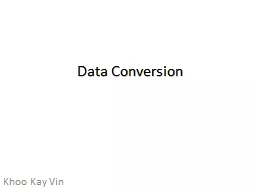

Khoo Kay Vin Data Conversion Convert Computer data from one format to another Example Words docx to pdf Image jpeg to png Audio mp3 to AAC Video avi ID: 151988
Download Presentation The PPT/PDF document "Data Conversion" is the property of its rightful owner. Permission is granted to download and print the materials on this web site for personal, non-commercial use only, and to display it on your personal computer provided you do not modify the materials and that you retain all copyright notices contained in the materials. By downloading content from our website, you accept the terms of this agreement.
Slide1
Data Conversion
Khoo
Kay Vin Slide2
Data Conversion
Convert Computer data from one format to another.
Example:
Words ( .
docx
to .
pdf
)
Image ( .jpeg to .
png
)
Audio ( .mp3 to .AAC )
Video ( .
avi
to .mpeg4 )Slide3
Data Conversion (cont.)move information from one system to another or one application to another.
fundamental differences in systems designed by different manufacturers.
information like names addresses and phone numbers transfer fairly easily
there are always some square pegs that simply wont fit in the round holes.Slide4
Data Conversion (cont.
)
4 methods of data conversions
Advantages & Disadvantages
Case:
A school, purchased new scheduling and accounting system based on database system that incompatible with the existing system.Slide5
4 method of data conversion
Direct Conversion ( plunge , direct cutover )
Parallel Operation Approach
Pilot Operation Approach
Phase-in ApproachSlide6
Direct Conversion
( plunge , direct cutover )Slide7
Direct Conversion
( plunge , direct cutover )
Least desirable approach
Stop old system, and start new system on a given date
In this approach the old system ceases and the new system commences
It is the cheapest of the four options, but it is the most risky.
Once in operation, do not have the old system to fall back on.
What happens if the new system has problems?
There is no back-up and data could be lost.
In an extreme case the organisation could suffer significant financial loss.
The direct cutover approach is normally used for the implementation of a purchased or standard system, where the chances of failure are low.Slide8
Parallel Operation ApproachSlide9
Parallel Operation Approach
In this approach both the old and new systems run together for a period of time.
It is only when any problems with the new system are identified and corrected that the old system is retired.
This is an expensive approach as everything is duplicated.
Can result in user resentment as there is an extra workload.
However, risk is minimised and a parallel operation changeover strategy would be recommended if we cannot afford to except any risk.
Best method for converting a manual to a computer system.Slide10
Pilot Operation ApproachSlide11
Pilot Operation ApproachIn this approach the new system is implemented in only one part of an organisation (i.e. in a pilot/test site).
The old system continues to operate in the other parts of the organisation.
Any problems with the new system are identified and corrected at the pilot/test.
Once this has occurs the new system can be implemented across the whole organisation, probably using a direct cut-over approach.
Pilot operation becomes an option when a new system is to be implemented in a series of sites or departments.
Can result in long conversion times.Slide12
Phase-in Approach(piecemeal approach)Slide13
Phase-in Approach(piecemeal approach)
In this approach the new system is implemented 'module' by 'module'.
-
eg
. Accounting packages are appropriate:
-accounts receivable
-accounts payable
-inventory
-sales
-payroll
The whole organisation receives parts of the system in stages.
The risk of failure is restricted to only part of the system being implemented.
This approach is incremental and is less costly than parallel changeover.
It is an option when a system can be broken up into self contained modules.
The changeover of each module could be carried out by direct cut-over or by parallel operation.
Users become familiar with the new system little-by-little before having to fully rely on it
Can also result in long conversion times.Slide14
Case: A school, purchased new scheduling and accounting system based on database system that incompatible with the existing system. Choose a method that does not impact the students in any negative manner.
From the above discussion about all four possible approaches, it is very clear that data cutover and parallel operation approach alone is not
suitable. Due to the
drawbacks like high risk or high cost but the combination of both approaches namely pilot operation and phased operation approaches is more fruitful.
Still phased operation is not most suitable approach as we know there are lot of phases involve in
the
information system and also
very costly.
So conclusion is
pilot operation is the most recommended approach
for
the school
because this method is cheaper and safer method
.Slide15
References:Shelly,
Cashman
& Rosenblatt,
Systems Analysis and Design, 6th Edition
, 8th Edition, Course Technology, 2006, 2010
.
http://149.144.20.200/subjects/IS/sem22010/lectures/l111implementation.html
http://en.wikipedia.org/wiki/Parallel_adoption
http://www.scribd.com/doc/396849/Developing-BusinessIT-Solutions